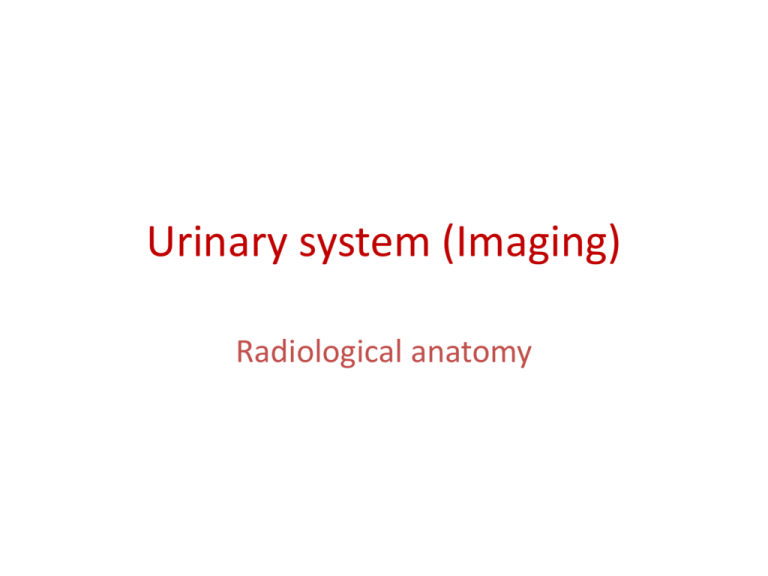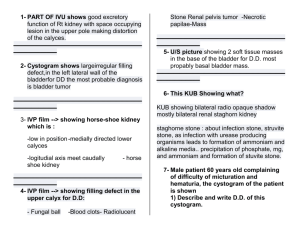Urinary system (Radiology)
advertisement

Urinary system (Imaging) Radiological anatomy Imaging Techniques Plane urinary Tract film. Kidney, Ureters and bladder(KUB). Intravenous urography. (IVU/EU). Ante grade and retrograde urethrography. Ultrasound. CT scan MRI Angiography Principles of Radiography The underlying physical principles of conventional radiography involve Emitting a stream of photons from x-ray source, strike body tissue. Photons with varying amount of energy exit the patient body and fall on image receptor/film, thus produce an image X-ray KUB Indications. Stone diseases. Help in diagnosis and management Abdominal pain Gall bladder stones Position and size of kidneys and bladder Show the position of ureteric stent Preliminary examination to contrast study Preparation. We use laxative, the night before the test to clear colon of solid fecal material. On good quality film psoas muscle should be visible INTRAVENOUS UROGRAPHY (IVU). Shows anatomy and functions of the kidneys. After injection of iv contrast, it concentrate in the kidneys. Excreted by kidneys and pass via ureters in to the urinary bladder. we take a series of films to follow the passage of contrast from kidneys to urinary bladder. Contrast Shows renal parenchyma, collecting system and ureters. Evaluate urothelial abnormalities,haematuria,urolithiasis. Scout film +/- abd preparation. Inject bolus of contrast Nephrogenic phase in first minute Pyelogenic phase after 5 minutes Supine,oblique,prone upright and post void film are taken Prone films to see distal ureters Voiding/Micturating cystourethrogram Functional and anatomical evaluation of bladder and urethra specially posterior urethra. Commonly for kids with recurrent UTI Dx.reflux,urethralvalve,uretrocele,urethral stricture and diverticula Scout film Pediatric 6-8F catheter For adult standard catheter Films during filling the bladder Oblique films Post void films You can see normal bladder film Retrograde urethrogram 8-16 F Foleys catheter. Fill balloon with2cc of contrast Inject 50% of contrast in to the bladder Take films in oblique position Some resistance at the membranous urethra and sphincter. Ascending urethgram in female Ultrasound Now a days first line investigation. Grey scale and Doppler Evaluate renal parenchyma, adrenals, bladder and prostate. Can differentiate between solid and cystic, hydronephrosis,shows all type of stone Evaluate congenital anomalies. CT scan Gold standard test. With and with out contrast Standard CT technique for renal imaging. 5mm collimation is adequate to demonstrate kidneys. IV contrast differentiate pathological process from normal. Parenchyma,coricomedullary differentiation max at 30 seconds Nephrogenic phase is best seen at 70100 seconds Non contrast helical CT shows any kind and small size of stone MRI ANGIOGRAPHY Congenital anomalies Cross ectopic. Lower kidney is usually ectopic one. In 90% of cases there is fusion of kidneys. There are increase chances of calculus formation. Horse shoe kidney. Lower pole of both unite in the middle. Prone to traume Pelvic kidney. Kidney is located in the pelvis. More prone to trauma. Duplicate collecting system. Complete/part Anamolies Nephrolithiasis • • • • Symptomatic/asymptomatic. Flank pain hematuria. Calcium phosphate stones are opaque on plane x-rays Uric acid and xanthine stones are radiolucent. All renal calculi have high attenuation(Opaque) on CT Sensitivity is 97% and specefity is 96% Can cause hydronephrosis, hydro ureter and renal enlargement Kidney and ureteric stones CT images of renal abscess with and with out contrast Renal cystic diseases Very common. 50% of patient over the age of 50 Associated with many syndromes Asymptomatic Rarely cause hematuria or become infected Smooth thin wall, sharp demarcation from surrounding parenchyma. Water attenuation on CT, non enhancing Simple cyst are with out septation or calcification Could be inherited like autosomal dominant or recessive Simple cyst in kidney on u/s and CT Renal cell carcinoma Most common malignancy 85% Associated with smoking, family history, age, von hippel Lindau, dialysis, phenacetin and acquired cystic diseases Present with wet loss,hematuria,pain,mass,fever and anemia Variable from complex cyst to large heterogeneous mass Generally enhancing May have calcification hemorrhage and central necrosis Wilms tumor Commonest kidney tumor in children. Peak incidence at 3-4 years of age 85% occur before years Hydronephrosis Distension and dilation of the renal pelvis and calyces. It is usually caused by obstruction to the free flow of urine from the kidney. If obstruction is at lower level, there is dilation of ureters and pelvis of kidney. Untreated , initially it cause enlargement of kidney, but finally it leads to atrophy.







